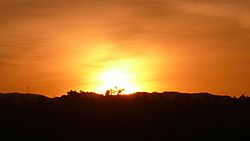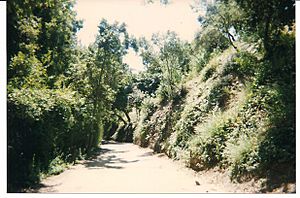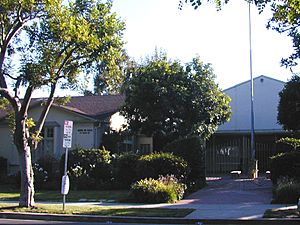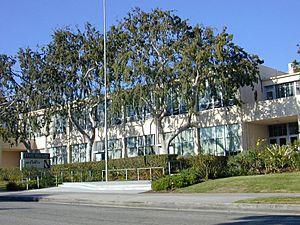Benedict Canyon, Los Angeles facts for kids
Quick facts for kids
Benedict Canyon
|
|
|---|---|
| Country | United States |
| State | California |
| County | Los Angeles |
| City | Los Angeles |
| Time zone | UTC-8 (PST) |
| • Summer (DST) | UTC-7 (PDT) |
Benedict Canyon is an area in the Westside of the city of Los Angeles, California.
To the north of the Benedict Canyon neighborhood is the neighborhood of Sherman Oaks, to the west is the neighborhood of Beverly Glen, to the east are Beverly Park and Franklin Canyon, and to the south is the city of Beverly Hills.
Contents
Geography
Benedict Canyon is a ravine that drops in a north-to-south direction from its high point at the crest line in the Santa Monica Mountains; to the east of the Canyon are its two sisters, Franklin Canyon and Coldwater Canyon. Rainwater percolating over the ancient strata of all three canyons emerges at their lowest altitude as the springs feeding Franklin's Lake and Creek. A cross-section of the land reveals granite, of volcanic origin, layered between worn river rocks and ocean bottom mud.
History
Benedict Canyon was a part of Rancho de las Aguas ("Ranch of the Waters"), which also included present-day Beverly Hills. It was named by Edson A. Benedict, a storekeeper and native of Boonville, Missouri, who took a homestead in the Canyon in 1868. With help from his wife and sons, E. A. Benedict built an apiary that was so bountiful that in one year, they were reported to have made a single shipment of 45,000 pounds (20,000 kg) of honey from Santa Monica Pier. One of Mr. Benedict's sons, Pierce E. Benedict, later went on to be elected to the city of Beverly Hills Board of Trustees at the time of its incorporation.
Author Timothy Leary spent the last years of his life in a house in Benedict Canyon, where he died in 1996.
Residences
Homes range from smaller one-story family residences to large properties. Homes are predominantly single-family and owner-occupied and have two or more bedrooms. The median year in which the homes were built is 1960.
In 2000, Benedict Canyon homeowners won a legal battle against the City of Los Angeles over the latter relaxing height requirements to allow a 45,000-square-foot villa that Mark R. Hughes had hoped to build on the area’s highest peak.
Vegetation and plants
Benedict Canyon has a mix of vegetation and growth that is endemic to Southern California: oaks and grasses on the lower slopes, and chaparral and lupine on the higher hillsides. Along nearby Franklin's Creek can be found sycamores, ferns and vines. Evergreens, such as pines, cypresses, deodars and eucalyptus, were planted as settlers moved in, and built homes and parks. Vegetation types within the Santa Monica Mountains range from moist coastal canyon bottoms in the Santa Monica Mountains, to desert transitional areas at the headwaters of the Santa Clara River. With the exception of the areas that border the Mojave Desert, all of the vegetation within the zone is influenced by the effects of the Pacific Ocean. The resulting cool, wet winters and hot, dry summers create a Mediterranean-type ecosystem.
By far, the dominant vegetation sub-type is chaparral. Chaparral is composed of drought- and fire-tolerant evergreen shrubs that range in height from four to ten feet. Unless recently subjected to fire, or some other type of disturbance, this plant community is generally too dense to penetrate. Another unique shrub community to Southern California is sage scrub, which varies between coastal and inland types. Sage scrub vegetation contains fewer stout, woody shrubs, and more openings with fine, delicate plants. The expansive valley floors between the mountain ranges were plowed and farmed long ago. They are now entirely developed. The precise former native plant cover of the San Fernando, Simi and Santa Clarita Valleys was never adequately recorded. It is suspected that native perennial bunch grasses were dominant elements. Throughout the zone, over ninety-five percent of the native grasslands have been displaced by foreign invasive plants. The most common riparian (stream-related) woodland species are various willows, coast live oak, California sycamore, and Fremont's cottonwood. Less common species that are relics of the last ice age include white alder, bigleaf maple, and black cottonwood. On slopes, and in valleys where rainfall concentrates, groves of evergreen coast live oaks are common throughout Benedict Canyon. These evergreen oaks provide food and shelter for numerous species of wildlife. Deeper soiled areas in the Santa Susana Mountains, the Simi Hills and the Santa Monica Mountains support the deciduous valley oak. A widely dispersed tree in the Santa Monica Mountains, and to a lesser extent in other ranges, is the California black walnut.
Wildlife
The animal population is pretty much the same as it was 10,000 years ago. Grizzly bears are an exception, as they were killed off by early Mexican and Spanish settlers. The most common medium and large-sized mammals are coyotes, mule deer, bobcats, raccoons, and skunks. Just away from the urban edge, other predators, such as grey fox, mountain lion, American badger, long-tailed weasel, and ringtailed cat, occupy various niches. The ecosystem's top predator, the mountain lion, is present everywhere except the fragmented eastern end of the Santa Monica Mountains that bisects the Los Angeles metropolitan area. Because they fear humans, however, they are rarely seen. Also, there are numerous prey species—such as rabbits, squirrels, rats, mice, and other rodents. Seven species of hawks, eight species of owls, peregrine falcons, golden eagles, northern harriers, American kestrels, and white-tailed kite share in this bounty of prey.
Benedict Canyon is also part of the Pacific Flyway. As a result, the resident Southern California bird species often share company with neo-tropical migrants and other unique species, such as Canadian geese. There are over eighteen species of snakes and eight species of lizards. The most common snakes are pacific rattlesnake, gopher snake, California king snake, and California striped racer. The rattlesnake is the only venomous snake in California. They seek shade during the hottest summer afternoons and hibernate during the winter. The zone supports five species of frogs, three species of toads, and five species of newts and salamanders. As in most parts of the world, frog populations have declined, probably due to climate change and pollution. The widely scattered perennial streams still support unique populations of native fish. Topanga and Malibu Creeks contain tidewater gobies, arroyo chub, and the endangered Southern California Distinct Population Segment of steelhead. The Santa Clara River supports these species as well as the federally listed endangered, unarmored three spine stickleback. Some of the upper reaches of the Los Angeles River at the foot of the San Gabriel Mountains harbor populations of the Santa Ana sucker and speckled dace.
Community
The Benedict Canyon Association (BCA), started in 1948, is an example of neighborhood activism. The BCA is dedicated to preserving the beauty, safety, environment and quality of life in the Canyon. Because of their early efforts, Benedict Canyon remains the only canyon that is 100% residential.
The Hillside Ordinance to limit building height at 36 feet (11 m) and stipulate restrictions on set-back, side yards or parking, was a product of Association lobbying and participation. That ordinance was also the basis of the recent defeat of the proposed villa on top of the Mark Hughes hilltop, an event cheered by many residents.
Current and past beautification projects of the Association include the repair and repaving of roads, repainting of guardrails, repair of Upper Benedict Canyon, and a subsidized monthly service of clearing debris and trimming vegetation that spills on the roadway.
"Adopt Fire Station 99" is another community grass-roots organization representing about 9,000 residents in the Mulholland-Benedict Canyon area. Going hand-in-hand with the BCA, residents helped to generate the media attention, popular support, and political will that defeated the city's plan to reduce from two to one the number of paramedics available at each Fire Station to deliver emergency care.
Celebrities
A number of notable people live or have lived in Benedict Canyon. Some of them are:
- Fred Astaire
- John Barrymore
- David Beckham
- Susan Berman
- Jacqueline Bisset
- Orlando Bloom
- Adrien Brody
- Ron Burkle
- Gerard Butler
- Mike Farrell
- Cary Grant
- Jimi Hendrix
- Thomas H. Ince
- Danny Kaye
- Kirk Kerkorian
- Robby Krieger
- Jack Lemmon
- Lisa Kudrow
- Mila Kunis
- Ashton Kutcher
- John Legend
- Jay Leno
- Harold Lloyd
- Jon Lovitz
- Demi Moore
- Phil McGraw
- Rupert Murdoch
- Roman Polanski
- George Reeves
- Emmy Rossum
- Timothée Chalamet
- Bruce Springsteen
- Sharon Tate
- Channing Tatum
- Kate Upton
- Rudolph Valentino
- Yvette Vickers
- Jon Voight
Fire danger
Bottlenecks on the neighborhood's narrow canyon roads have been noted as a primary concern. As part of the plan, the Department of Transportation tows away cars that are parked illegally on narrow hillside streets on "red flag days," when fire danger is high. When fire conditions reach the critical red flag level — 25 mph (40 km/h) wind and relative humidity below 15% — illegally parked vehicles that restrict access are ticketed and towed. Fire departments notify residents by raising red flags over the 103 fire stations in Los Angeles. Over the last ten-plus years (2015), the maximum number of Red Flag days per year was 12. The normal range is between four and seven days per year.
Brush clearance is a year-round responsibility for those homeowners living in Benedict Canyon. Fire officials said that both the foliage and the lack of recent fires in the area are cause for concern, not comfort, noting the Oakland Hills fire of October 1991 that killed 25 and destroyed 3,276 residences under similar conditions.
Emergency services
The Los Angeles Police Department operates the West Los Angeles Community Police Station at 1663 Butler Avenue, 90025, serving the neighborhood.
The Los Angeles Fire Department serves the area of Benedict Canyon. Fire Station 71 and Fire Station 99 serve the Benedict Canyon Area.
Education
Residents are assigned to schools in the Los Angeles Unified School District:
- Warner Avenue Elementary School
- Emerson Middle School
- University High School







